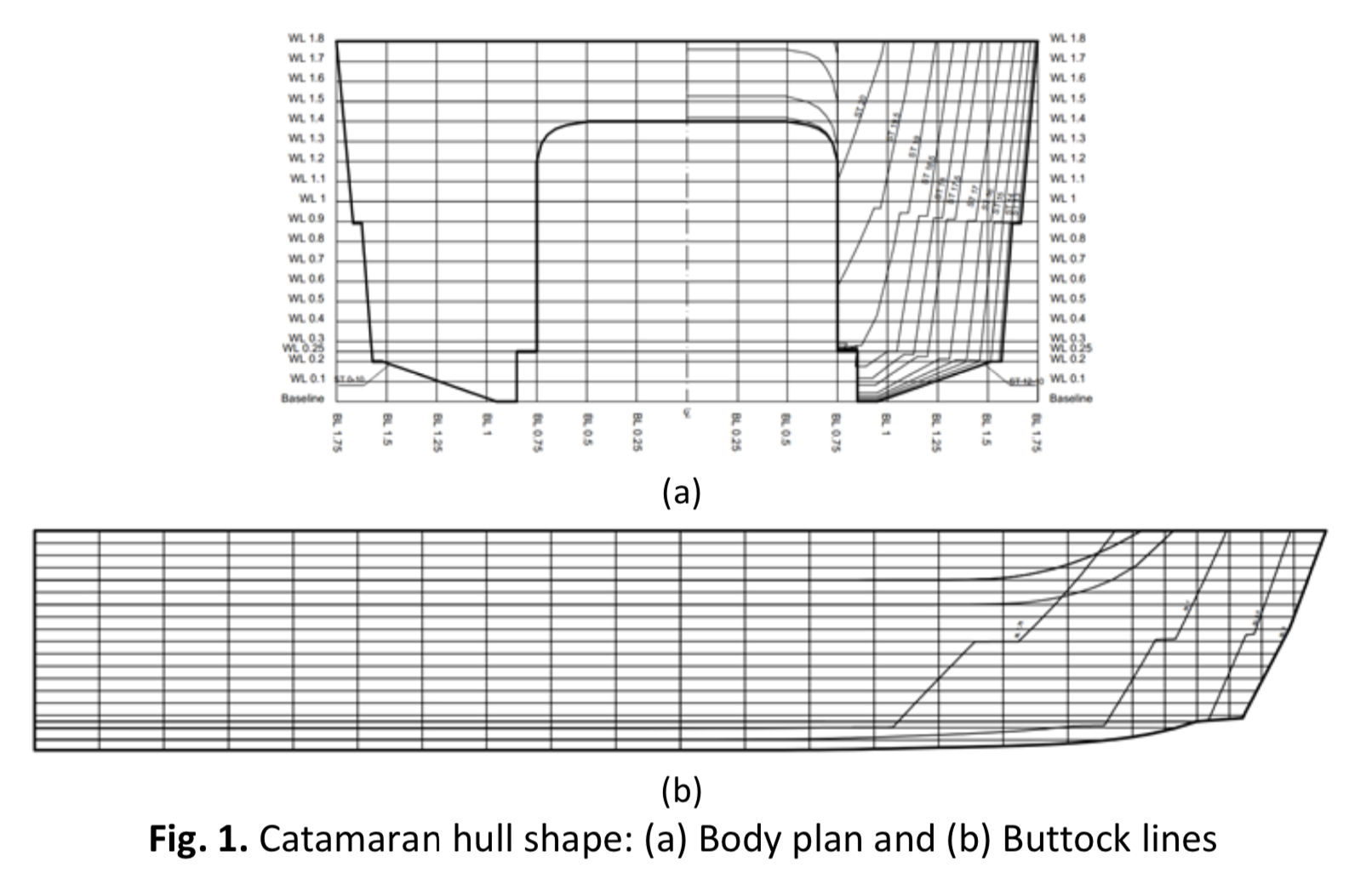Resistance Analysis of a Hydrofoil Supported Watercraft (Hysuwac): A Case Study
DOI:
https://doi.org/10.37934/cfdl.14.1.8798Keywords:
Catamaran, CFD, energy efficiency, Hysuwac, ship resistanceAbstract
Energy efficiency and environmental sustainability are important aspects in ship design and operation. Hull-shape optimization, hull cleaning and coating, and the use of appendages are, among others, well-known efforts to reduce ship fuel consumption. Regarding energy efficiency and environmental sustainability, it is possible to effectively reduce the resistance of an existing catamaran by retrofitting a foil system to it. In this study, a foil system is designed and retrofitted to a catamaran to reduce its total resistance. Reynolds-averaged Navier-Stokes simulations, utilizing k-w SST turbulence model, were performed to study the effects of the foil system on the vessel’s total resistance. Free surface effects were modelled, i.e., the generation of waves due to the vessel’s movement on the water surface. The foil system affects the wetted surface area, running sinkage and trim, and the wave pattern generated by the vessel, which ultimately affect the vessel’s total resistance. At relatively low speeds (Fr < 0.7), an increase of the total resistance, reaching a value of approximately 11%, was observed due to the foil system. However, at higher speeds (Fr > 0.7), the foil system decreases the total resistance, reaching a value of approximately 32% at the service speed (Fr = 1.24). The 32% resistance reduction at the service speed is promising in view of the intended purpose of the foil system as an energy saving device.
Downloads
References
Bouckaert, Bruno, K. Uithof, N. Moerke, and P. G. Van Oossanen. "Hull Vane on 108m Holland-Class OPVs: Effects on Fuel Consumption and Seakeeping." In Proceeding of MAST Conference. 2015.
Uithof, Kasper, N. Hagemeister, B. Bouckaert, P. G. Van Oossanen, and N. Moerke. "A systematic comparison of the influence of the hull vane, interceptors, trim wedges, and ballasting on the performance of the 50 m AMECRE series 13 patrol vessels." Proc. Warship 2016: Advanced Tech. Naval Design, Constr. Operation, Bath, UK (2016).
Suastika, Ketut, Affan Hidayat, and Soegeng Riyadi. "Effects of the application of a stern foil on ship resistance: A case study of an Orela crew boat." Int. J. Tech 8, no. 7 (2017): 1266-1275. https://doi.org/10.14716/ijtech.v8i7.691
Yun, Liang, Alan Bliault, and Huan Zong Rong. High speed catamarans and multihulls: technology, performance, and applications. Springer, 2018. https://doi.org/10.1007/978-1-4939-7891-5
Hoppe, K. G. "Boats, Hydrofoil Assisted Catamaran." SA Patent 80 (1980): 5400.
Hoppe, K. G. "Boats, Hydrofoil Supported Catamaran." SA Patent 82 (1982): 3505.
Hoppe, K. G. "Recent applications of hydrofoil-supported-catamarans." Fast Ferry International 36 (2001).
Calkins, D. E. "HYCAT: hybrid hydrofoil catamaran concept." Ocean engineering 11, no. 1 (1984): 1-21. https://doi.org/10.1016/0029-8018(84)90021-0
Miyata, Hideaki. "Development of a new-type hydrofoil catamaran." Journal of ship research 33, no. 02 (1989): 135-144. https://doi.org/10.5957/jsr.1989.33.2.135
Najafi, Amin, Hashem Nowruzi, and Hassan Ghassemi. "Performance prediction of hydrofoil-supported catamarans using experiment and ANNs." Applied Ocean Research 75 (2018): 66-84. https://doi.org/10.1016/j.apor.2018.02.017
Azad, M. Torabi, A. Nowruzi, and M. Sadeghi. "A numerical analysis of hydrofoil operation near the water surface and development of a method to calculate the HYSUCAT dynamic performance in the conceptual design phase." Indian Journal of Geo-Marine Sciences 47, no. 8 (2018).
Yao, G., Y. Liu, Y. Zhao, and P. Qiu. "Study on the influence of hydrofoil on the resistance of catamarans based on STAR-CCM+." Wuhan Ligong Daxue Xuebao (Jiaotong Kexue Yu Gongcheng Ban)/Journal of Wuhan University of Technology (Transportation Science and Engineering) 42, no. 4 (2018).
Kazemi Moghadam, H., Rouzbeh Shafaghat, and A. Hajiabadi. "Foil Application to Reduce Resistance of Catamaran under High Speeds and Different Operating Conditions." International Journal of Engineering 32, no. 1 (2019): 106-111. https://doi.org/10.5829/ije.2019.32.01a.14
Li, H. J., A. M. F. Putra, K. Sun, J. X. Leng, H. X. Zhao, and J. H. Chen. "Boat Trial Validation and Resistance Prediction of a 36-Foot Hydrofoil Catamarans Using CFD." Chuan Bo Li Xue/Journal of Ship Mechanics 24, no. 6 (2020).
Suastika, Ketut, Agung Silaen, Muhammad Hafiz Nurwahyu Aliffrananda, and Yuda Apri Hermawan. "Seakeeping Analysis of a Hydrofoil Supported Watercraft (Hysuwac): A Case Study." CFD Letters 13, no. 5 (2021): 10-27. https://doi.org/10.37934/cfdl.13.5.1027
Hoppe, Karl-Gunther W. "Catamaran with hydrofoils." U.S. Patent 4,606,291, issued August 19, 1986.
Abbott, Ira H., and Albert E. Von Doenhoff. Theory of wing sections: including a summary of airfoil data. Courier Corporation, 2012.
Suastika, Ketut, Ahmad Firdhaus, Rajabal Akbar, Wasis Dwi Aryawan, I Ketut Aria Pria Utama, Soegeng Riyadi, and Bharathram Ganapathisubramani. "Experimental and numerical study of ship resistance due to variation of hull vane® positioning in the longitudinal direction." in Proceedings of International Conference on Ship and Offshore Technology. 2019.
Numeca International. "FINE/Marine 7.2 Theory Guide." Belgium, 2018.
Menter, Florian R. "Two-equation eddy-viscosity turbulence models for engineering applications." AIAA journal 32, no. 8 (1994): 1598-1605. https://doi.org/10.2514/3.12149
Bardina, J. E., P. G. Huang, and T. J. Coakley. Turbulence modeling validation, testing. and development, technical report, NASA, US. NASA Technical Memorandum, 1997. https://doi.org/10.2514/6.1997-2121
Hirt, C.W. and B. D. Nichols. "Volume of fluid (VOF) method for the dynamics of free boundaries." Journal of Computational Physics 39, no. 1 (1981): 201-225. https://doi.org/10.1016/0021-9991(81)90145-5
Maxsurf. "MAXSURF Naval Architecture Software." 2021.
Ferziger, Joel H. and Milovan Perić. Computational methods for fluid dynamics. 3rd Ed. Berlin: springer, 2002. https://doi.org/10.1007/978-3-642-56026-2
Anderson Jr., John D. Computational fluid dynamics: the basics with applications. New York: McGraw-Hill Inc., 1995.
Faltinsen, Odd M. Hydrodynamics of high-speed marine vehicles. Cambridge university press, 2005. https://doi.org/10.1017/CBO9780511546068




























